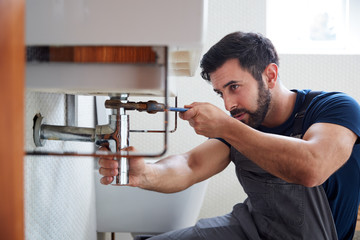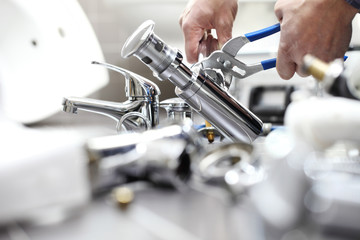The Common Causes of Plumbing Problems
Plumbing is the system of pipes and fixtures that conveys water for heating, cooling, waste removal, and more. The plumbing system must comply with several regulations and standards to function properly.
Plumbers are skilled professionals who can handle the installation and repair of plumbing fixtures and pipes. They often work in homes and business properties. To learn more, visit https://www.plumberscranton.com/.
Whether they’re running through the ground or under your house, pipes can be susceptible to damage. Cracks and holes can be caused by a number of factors including earthquakes, shifts in the ground, tree roots, or simply age. If these cracks go untreated, they can cause serious water and sewage problems. It’s important to keep an eye on the condition of your pipes and act quickly if you notice any damage.
Pipes can also be damaged by corrosive soils. This can cause the metals in the pipes to break down, which can lead to corrosion and eventually cracking or breaking. Other causes of cracking include cyclic load conditions, vibrations, and thermal expansion and contraction. Pipes aren’t indestructible, but with proper care they can last for decades.
In many cases, a leaking pipe can be repaired by replacing the affected section of the pipe. However, in some cases, it may be necessary to replace the entire pipeline. When this is necessary, a plumber can help you choose the right materials to ensure a long-lasting solution.
With most of the pipes in your home hidden behind walls and underground, it can be difficult to know when there is a problem. However, there are a few common symptoms that can indicate a problem such as damp walls and ceilings, foul smells, and low water pressure. If you notice any of these symptoms, it’s important to call a plumber as soon as possible.
A broken sewer line is another common plumbing problem. If you have a clog in your toilet or shower that won’t go away, it could be a sign of a faulty sewer line. In the worst cases, a cracked sewer line can allow soil and even tree roots into the pipes, causing serious and expensive damage.
Sewer lines are typically buried underneath the ground and in concrete slabs, so they aren’t as flexible as other pipes. If the ground or slab moves, it can put strain on the pipes and cause them to crack. This type of damage can also happen if someone drives over the line with heavy equipment or accidentally digs into it. Underground lines should always be clearly marked before digging or landscaping.
Root intrusion
Root intrusion is one of the most common causes for sewer line blockages. The roots of nearby trees are attracted to the moisture in the sewer lines, which acts as a natural fertilizer. The roots grow rapidly inside the pipes, eventually causing them to crack or break. Once a pipe is cracked or broken, it can lead to sewage backups and other serious problems.
The best way to avoid root intrusion is to have your sewer lines regularly inspected by a plumber or drain cleaning service. These professionals will use a camera to look for any cracks or other damage to the pipes. They can also inspect the lining of the pipe to ensure it is intact and not allowing roots into the interior of the pipe.
If you notice that your toilet is flushing slowly or that it makes a gurgling sound when you drain water, this is a sign that there is a problem with the line. This could be caused by a clog or by water that is backing up into the plumbing system. It is important to call a plumber right away so that the issue can be addressed before it gets worse.
Many homeowners do not realize they have a root intrusion problem until it is too late. When the root growth has become severe, it can cause a sewage backup into the home, which is both dangerous and expensive to fix. The roots can also clog the entire sewer line, which can be even more costly to repair.
Roots can be a major problem for sewer lines, especially in older homes with clay or cast iron pipes. The solution to this problem is often a cured-in-place pipe (CIPP). During this process, an epoxy lining is applied to the inside of the sewer pipes, which seals any cracks or holes and prevents future root intrusion. It is also possible to replace the old pipes with newer, more resistant materials like PVC or HDPE. This can help to avoid the high costs associated with replacing and repairing damaged pipes.
Damage to the pipe’s interior
Despite their sturdy exterior, pipes can still suffer damage from within. This type of damage is known as corrosion. Corrosion can be caused by water leaks, mineral buildup, shifts in pressure and temperature, and other factors. In addition, a pipe can also be damaged by outside forces such as tree roots, construction projects near the plumbing system, or vibrations from nearby traffic.
Leaking pipes often cause extensive damage in the home’s interior. The resulting moisture can ruin drywall and other surfaces, forcing owners to make costly repairs. It can also lead to wood rot, which affects structural beams and support structures. Additionally, a burst pipe can release sewage and other waste materials into the house, creating an unsafe environment for residents.
When a water line or pipe suffers damage, it is important to take immediate action. However, it can be difficult to identify and locate all the damage that has occurred. This is especially true for smaller pipes that carry water inside the home, such as those that connect to bathroom and kitchen sinks. A plumber can help to identify these problems and determine the best course of action for repair.
Some of the most common signs that a pipe is damaged are the appearance of discoloration or water streaks on walls or floors. You should also pay attention to any unusual sounds that might be coming from your pipes, as this could indicate that they are leaking or bursting. Finally, you should keep an eye on your water meter to see if it is increasing faster than normal. If you notice any of these signs, it is important to contact a professional plumber as soon as possible.
Damage to the pipe’s exterior
Pipes aren’t immune to damage caused by environmental factors. For example, if the pipes are located outdoors or near the ocean, they may be susceptible to corrosion. The water’s salt content can eat away at the metal and cause it to corrode, which will eventually lead to the pipe breaking down. This can be a big problem for homes, especially since the leaks can damage the house and its contents.
The pipes are also at risk of damage from extreme temperatures. The freezing temperatures of winter can cause the water in your pipes to freeze and expand, which can cause them to break. This can be a major problem if the pipes aren’t properly insulated or the temperature changes are sudden.
Another potential cause of plumbing damage is improper installation. If the pipes aren’t installed correctly, they can start to leak or burst. This is often the case when the pipes are connected to appliances like toilets or washing machines. It’s important to hire a plumber to install your pipes correctly to avoid this type of damage.
The last thing you want is to wake up to a flooded basement or see water spots on your walls and ceiling. This type of damage can be very costly to repair, and it could even be beyond the scope of your homeowner’s insurance. In addition, it can leave your home vulnerable to further issues and can even affect its value.
One of the most common causes of residential plumbing damage is a broken pipe. A damaged pipe can leak sewage into your home’s water supply, causing extensive damage and creating health hazards for you and your family. Fortunately, there are ways to protect yourself from this issue by doing regular maintenance on your plumbing and by having your pipes regularly inspected.
Detecting and fixing a plumbing issue early on can save you money, time, and disruption to your life. If you notice a plumbing problem, such as a leak or a clogged drain, be sure to shut off the water valve (if possible) and turn off any electrical outlets that could be exposed to water. You should also contact a plumber as soon as possible to prevent further damage.



